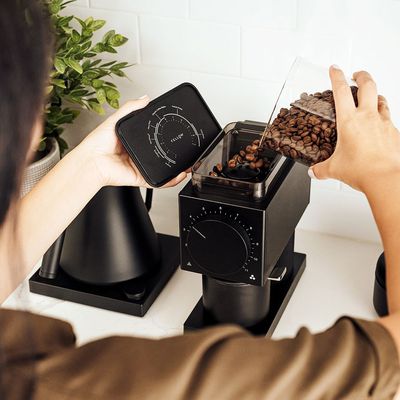
It seems everyone, including us, is always looking for baristas to tell them how to make a café-level cup of coffee at home. We’ve heard about everything from water filters to cupping spoons, but the most common advice is to grind your own beans. Which is where folks (without an unlimited budget) often hit their first problem: The best coffee grinder, according to some baristas, is Baratza’s $900 Forte, a flat-burr grinder beloved by coffee snobs for how precisely it can grind beans at home or in restaurants (where it’s frequently used). While baristas have told us that a $150 conical-burr grinder from Baratza (which I own) is a viable alternative, they admit its design yields less precise grinds and is far “chattier” (i.e., louder) because the gadget is made mostly of plastic.
That’s why I paid special attention back in April when multiple baristas excitedly told me about a then-still-in-development flat-burr grinder they believed would finally make the technology found in their $900 favorite a lot more accessible. That grinder — the $299 Ode from Fellow, the maker of our favorite kettle — promised “big, flat burrs that are the same as those in commercial grinders, but in a home machine,” as barista Zachary Elbourne of Bedford-Stuyvesant’s Burly Coffee put it. “I’m sure anyone you ask will tell you about it. The only thing close is the Baratza Forte.” He wasn’t wrong: Barista Reagan Petrehn of Felix Roasting Co. told me the Ode would be “an amazing addition to the home grinder landscape,” and the fact that Fellow’s Kickstarter fund to develop the grinder reached its $200,000 goal in just 94 minutes suggested countless others felt the same.
As someone who has ground his own coffee at home for going on three years, I’ve learned from experience (and helpful baristas along the way) that there are many benefits, from actually being able to taste the flavors promised on the coffee packet to the smell of coffee filling my kitchen each morning. While my (relatively) affordable Baratza conical grinder delivers these benefits, it hasn’t been without headaches. For one, its (too) many dial settings require a lot of fiddling, making it hard to, say, go from grinding beans for a French press to beans for a pour-over brew without resulting in some bitterness. Plus, its chatter is downright unpleasant, especially early in the morning. (To those who say “A hand grinder is quieter!” I say: None will yield grinds on par with any flat-burr grinder.) In addition to offering flat-burr grinding at a more reasonable price point, the Ode also promised to do its job far more quietly than its competitors. After our friends at Grub Street praised it in a prerelease review, I finally got my hands on one in September (to be clear, the brand sent it to me) and have been putting it to the test every morning — and many an afternoon — since.
It didn’t take long to confirm that the Ode delivers on its promise of being a quieter grinder. Although it’s not silent, the noise it makes isn’t at all unpleasant (I’d compare it to the sound of crumpling up a newspaper). It’s also satisfyingly easy to use: Unlike my Baratza grinder, all it takes to accurately adjust grind size is a turn of its pleasingly giant dial. With only one button on the entire device, it’s truly quite hard to get a step wrong, even before you’ve had a morning cup. There are other thoughtful details that anyone will appreciate, including an automatic shut-off function and a small footprint (it takes up less counter space than a small conventional toaster). There are also thoughtful details that coffee nerds will appreciate, including a magnetic base in the grinds receptacle that makes it a cinch to remove and replace (Grub Street compared it to the feeling of putting AirPods back in their case) and a steel tab you can flick to ensure that all the grinds make it into that receptacle (an essential after you have gone to great pains to weigh your beans before grinding them).
I have used the machine for French press, pour-over, and AeroPress coffee, and every cup tasted smooth, no matter the method. As far as how the taste compares to that of grinds from my Baratza, I have consistently been able to detect very specific notes from coffee ground by the Ode, whereas I sometimes need to grind beans two or three times in the Baratza to brew the perfect cup. The underside of the Ode’s lid has a handy guide to the best dial settings for the seven brewing methods it accommodates — which do not include espresso. (But Elborne says that’s a good thing: “Too many grinders try to do both and end up doing neither well.”) By following that guide, I can taste the apricot, baker’s chocolate, and honey notes in my Oslo beans just as strongly in all the brewing styles I’ve tried.
The Strategist is designed to surface the most useful, expert recommendations for things to buy across the vast e-commerce landscape. Some of our latest conquests include the best acne treatments, rolling luggage, pillows for side sleepers, natural anxiety remedies, and bath towels. We update links when possible, but note that deals can expire and all prices are subject to change.







